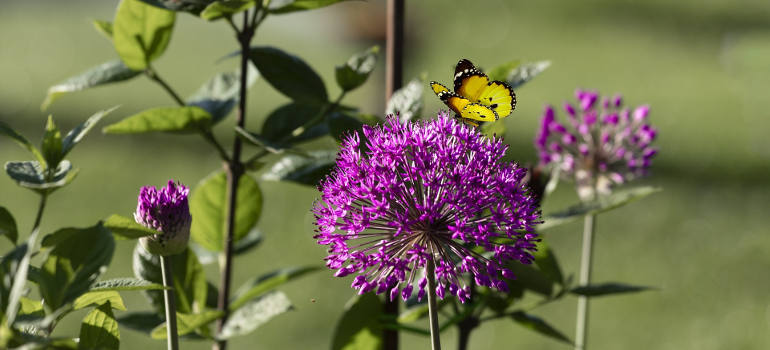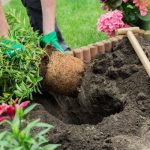
With the massive industrialisation, intensive agriculture, and expansion of urban areas that has occurred in the UK since the 1950’s, we have lost 96% of the wild meadows which once dotted the landscape.
While this is difficult to remedy due to the demands associated with an ever-increasing population, there are steps we can take to address the issue locally. One of the best (and easiest) options is creating a wildlife garden. With a little bit of work, you can turn your garden into a haven for a variety of beneficial insects and also animals.
Table of Contents
The benefits of wildlife garden
Why is providing a welcoming habitat for birds, small mammals, and insects important? The wildlife habitats of many species are being destroyed and, as an end result, we are losing many native species at an alarming rate. This has a negative cumulative effect on the biodiversity of the entire country. Many of the species we are losing play a major role in pollinating plants and in maintaining a natural balance by keeping the populations of nuisance animals and insects in check.
The most important role insects and other critters fulfil is that of pollinators. Although pollen can be spread by the wind, many flowers, fruits, and vegetables rely on insects to carry pollen from one plant to another. This allows them to produce fruit and seeds.
If the environmental reasons are not enough to convince you, then it is worth considering that the market for insect-pollinated fruit and vegetables in the UK is worth an estimated 220 million GBP. Declining insect populations have serious consequences for British farmers in terms of increased prices as we become heavily reliant on imports.
So, how can you attract wildlife to your garden? You will be happy to learn that this is not very difficult! You don’t have to change your garden on a massive scale if you don’t want to or if you don’t have enough space. It can be as simple as changing the type of flowers you plant or as complicated as entirely redesigning your garden. So, let’s take a closer look at some ideas how to attract wildlife to your UK garden?
Planting for wildlife
One of the easiest ways to encourage wildlife to your garden is planting the appropriate greenery that birds, insects and other beneficial creatures love.
Choose the right flowers
Flowers provide an excellent source of pollen and nectar for bees, butterflies, moths, and other insects. Try to avoid flowers with big or double flowers, such as tulips, roses, and daffodils. Instead, plant flowers like violets, marigolds, and sunflowers. This will help attract many beneficial, pollinating insects to your garden and once these come, other animals will follow suit as well.
Sow wildflowers and grow a meadowland
If you have space, you can let a section of grass in your garden grow a little longer than usual and sow wildflower seeds. This will create a small meadowland of your own. Not only is it low maintenance and pretty, but it is also the perfect habitat for bees and butterflies.
Grow wildlife-friendly shrubs for birds and insects
To add more layers and levels to your garden, consider planting edible shrubs, such as blackberry and redcurrant. That way, you will harvest some delicious, home-grown berries. Small mammals will also be able to get a tasty snack and these shrubs are also favoured by bees and butterflies.
Build a small rock garden
Pile old rocks, bricks, and tiles in a quiet corner of your garden to provide a home for many species of insects and small mammals. Once you have built the small bug hotel, you can just leave it alone as nature will reclaim it over time. This will increase the diversity of species that will end up calling it their home. Here’s our take on how to build a rockery.
Set up bird boxes
Setting up bird boxes, as well as providing drinking water and food for birds will give a much-needed respite to different species of birds, which are losing their natural habitats. Putting out a variety of food, such as fat balls, peanuts, and seeds will quickly attract birds and help them survive during the winter months. This will also aid the growth of young chicks in the spring.
If you would like to know more about attracting birds to your garden, check out our article here.
Add a water feature
Adding a water feature, like a small pond, is a great way to attract a variety of amphibious creatures to your garden. And, as natural water plants establish themselves, you will soon notice a boom in the population of different species – from frogs to newts.
The best thing is that they will also help keep populations of flies and other undesirable insects down to a minimum. If you don’t have the space to build a pond, large pots and upturned bin lids will work just as well.
Leave dead wood in a shady area
Similar to the rock garden you built in the corner, leaving a pile of dead wood in a shady area is the perfect habitat for many species of fungi and invertebrates, such as millipedes and woodlice.
Compost
Composting helps to lower your household waste as you will be putting leftovers, peelings, and other food waste into your compost bin or heap instead of sending it to a landfill. You will also have a natural fertiliser at hand to feed all of the plants and shrubs in your garden. The benefits don’t stop at the personal level, though – compost heaps and bins are great habitats for earthworms, frogs, spiders, and garden snakes.
If you are interested in learning how to recycle your food waste, check out our article on composting here.
Introduce sustainable gardening
Now that you have started walking down the road of wildlife gardening, you may be wondering what the next step is. If you would like to take your garden to the next environmentally-friendly level, you can consider sustainable gardening.
Sustainable gardening is basically the idea of minimising your reliance on products which are energy intensive to produce and that often contain harmful chemicals. Instead of using synthetic pesticides, you can try companion planting. This is the process of pairing plants which are beneficial to each other.
Many planting combinations provide various benefits, such as natural pest control, improved soil health, and attracting of predatory insects which eat plant-munching bugs (aphids and the like).
Scare away unwanted visitors
So, you’ve built a garden wildlife and all of the critters have started to call your garden home. But now you have some unwanted visitors that are upsetting the balance and scaring away some of the inhabitants. Next, we will discuss what you can do to keep some of the most common trespassers away.
Cats
Our little furry friends may appear cute and innocent, but underneath that facade exists a darkness matched only by the depths of hell. Almost every gardener is aware of what a nuisance cats can be, digging up plants and killing the birds you worked so hard to welcome into your garden. Hope is not lost though as there are steps you can take to deter these cute killing machines.
- Place taut wire or string 10-15 cm above the top of your fences. This makes it very difficult for cats to maintain their balance.
- Planting, or simply piling, spiky or thorny bushes under bird feeders will prevent cats from being able to pounce on our unsuspecting bird friends while they eat.
- Tie old CD’s to a string and hang it from a tree’s branches. The reflected light is said to deter cats.
Squirrels
Who doesn’t love squirrels? From a distance, they are whimsical, bushy-tailed tree dwellers. But for gardeners and bird lovers, squirrels are a greedy nuisance which devours the food that was meant for our feathered friends. Use these methods to keep the little buggers away from the bird food.
- Mix chilli powder or sauce in with the bird food. Birds cannot taste chilli and are not bothered by it in the least. Squirrels, however, can taste chilli and quickly learn that your garden is not an all-you-can-eat squirrel buffet.
- Buy a bird feeder with a spring-loaded cover. When squirrels jump onto the feeder, their weight will close the cover and deny their little squirrel paws a treat.
- If you don’t want to buy a fancy, spring-loaded bird feeder, then simply place a downward-facing biscuit tin beneath the bird table or put a cut in half bottle over the top of the feeder. This will stop squirrels from being able to either climb onto the bird table or climb down onto the feeder.
Gulls
Gulls are most famous for snatching your food in daring, dam buster-esque ways at the seaside. How many of us were just about to enjoy a fresh fish and chips when a cheeky, devil bird had swooped down and flew away with our dinner? All too many.
However, the destruction of the gulls’ natural habitat is forcing them inland, while their numbers decline. This is causing gulls to become a nuisance to a larger section of the population.
- Gulls tend to congregate where there is an abundant food source, so the easiest way to deter them is to not purposely feed them.
- If possible, also dispose of your rubbish in a wheelie bin or trash can as gulls can easily rip open plastic bin bags.
Pigeons
We share a lot of space with pigeons: in our city centres, in our gardens, and above our cars. While they are not as much of a nuisance as cats or squirrels, pigeons can carry diseases and harmful pests, such as mites and ticks. Luckily, they are quite easy to deter.
- Prevent access to food by making sure all food waste is disposed of properly or composted. I If you feed other smaller birds, choose feeders with an anti-pigeon mesh.
- Installing netting over building recesses can help stop pigeons from nesting.
- Ledges can also be fitted with metal spike strips to stop pigeons from landing and resting.
There we have it, you now possess the necessary knowledge to build and maintain a wildlife-friendly garden. So, go forth and create an ecosystem to house and support local wildlife!
If you are unsure of how to proceed or would like an extra pair of helping hands, contact us for a quote and our Fantastic Gardeners team will be more than happy to help. If you already know what you need done in the garden, then you can easily find it and get an appointment through our booking form below.
Need a professional gardener?
Enter your postcode to view our rates and availability in your area.
For questions about the services we offer visit our main site
***
Did we miss anything? Do you have any tips for us or our readers on how to create a wildlife garden? Let us know in the comments below or give us a shout on social media!




It was a extremely detailed article and very interesting and helpful. I love gardening and greenery. Thanks for sharing this post.
Great to know! Greetings, Zahoor!
This is really informative and great content on wildlife garden.
perfect, thank you, i needed to know how to stop the gulls and pigeons, could you please tell me if the flowers are perennial if not do i need to clear them out every autumn and re seed? Hazel.
Get a lot of foxes around here mice & rats what can I do about them